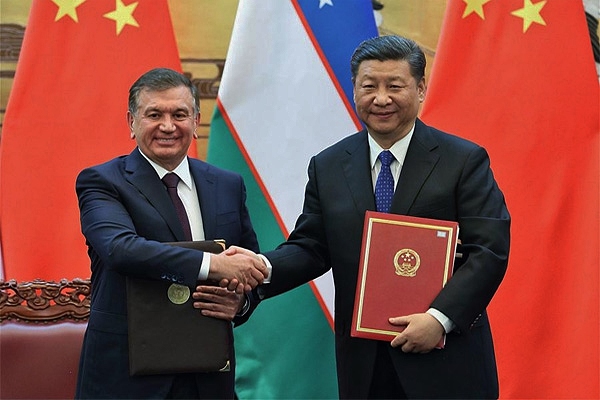
Uzbekistan’s Economic Ties to China Continue to Grow Under New President Mirziyaev
Publication: Eurasia Daily Monitor Volume: 14 Issue: 71
By:

President of Uzbekistan Shavkat Mirziyaev’s five-day trip to China earlier this month (May 11–15) has signaled that he is now moving on from the first phase of his foreign policy activities (Ng.ru, May 11). Since President Mirziyaev took office last December, priority was first accorded to Uzbekistan’s immediate neighbors: he has either hosted or visited the leaders of each of the countries bordering on Uzbekistan, except for Tajikistan and Afghanistan. But in the second phase, the focus is now on Uzbekistan’s most significant partners outside the region, Russia and China, visited by the president in April and May, respectively. Cumulatively, these visits delineate President Mirziyaev’s foreign policy priorities. The Russia and China trips highlight limited deviations from Uzbekistan’s previous foreign policy under then-president, Islam Karimov, for whom these two countries were the closest partners by choice and need.
Mirziyaev’s recent trip to China consisted of two parts: an official state visit and participation in the international One Belt, One Road forum, held in Beijing. Of the regional leaders, President of Kyrgyzstan Almazberk Atambayev and President of Kazakhstan Nursultan Nazarbaev also participate in the forum. The significance and high priority of the China trip for Uzbekistan was signified by Shavkat Mirziyaev’s entourage of nearly all senior government officials in his administration: Foreign Minister Abdulaziz Kamilov, Deputy Prime Minister Rustam Azimov, Deputy Senate Speaker Sodiq Safayev, Minister of Foreign Economic Relations and Trade Elyor Ganiyev, and Defense Minister Kabul Berdiev (Ozbekiston via BBC Monitoring, May 14).
Mirziyaev was meeting President Xi Jinping in his new role as president of Uzbekistan for the first time, but both had dealt with each other in the past. During President Xi’s visit to Uzbekistan in 2016, then–prime minister Mirziyaev personally accompanied him on a sightseeing trip to Bukhara (Gazeta.uz, June 21, 2016). The previous personal acquaintance likely helped the two heads of state to swiftly move to substantive talks, without first spending time on warm-up “get to know each other” sessions. President Mirziyaev returned from China with cooperation agreements worth $20 billion, the largest amount so far since bilateral relations were established (Uzdaily.uz, May 13). The agreements were mainly in the real sector of the economy, such as improvements in the quality of education in Uzbekistan, the modernization of medical facilities, agriculture, the modernization of 299 water pump stations, and the production of synthetic liquid fuel (Gazeta.uz, May 13).
To put the May 2017 China-Uzbekistan meeting in perspective, when the last time the countries signed bilateral agreements, in 2013, they agreed on $15 billion worth of deals (Uza.uz, September 9, 2013). At that time, President Xi first announced his Silk Road Initiative—China’s road and railway plans traversing Central Asia—in Kazakhstan, right before his visit to Uzbekistan (The New York Times, September 7, 2013). It also bears noting the Uzbekistan’s latest cooperation agreements with China were even larger than the bilateral cooperation agreement President Mirziyaev signed with the Russian government in April, during his visit to Russia. Last month’s deal with Moscow amounted to $15 billion (Izvestia, April 5).
China has thus become nothing short of a true strategic partner for Uzbekistan. Beijing co-funded the first and only railroad connecting the Ferghana Valley, the most eastern corner of the country, with the rest of Uzbekistan. The connection is crucial for trans-regional railroad projects to ship Chinese goods as well. Now with that railroad complete, China has committed to an equally strategic $175 million motorway project to run parallel to the railroad in the Ferghana Valley (Gazeta.uz, May 15).
Bilateral trade between China and Uzbekistan has reached $4.2 billion, but fell slightly short of the targeted $5 billion set by President Xi himself back in 2013 (Lenta.ru, September 9, 2013). Coincidently, bilateral trade between Russia and Uzbekistan has also now reached $4.2 billion (Anhor.uz, February 16). During their latest summit, Uzbekistan and China set a new bilateral trade target of $10 billion, without providing a concrete date for when this goal should be reached (Uzdaily.uz, May 15). In terms of investments in Uzbekistan’s economy, China is slightly ahead of Russia: China invested a total of $8 billion to date, while Russia invested over $7 billion (Uzdaily.uz, May 15; RIA Novosti, March 23).
During the One Belt, One Road forum, President Mirziyaev spoke about Uzbekistan’s role in the initiative and highlighted a planned China–Kyrgyzstan–Uzbekistan–Afghanistan railroad connection as a strategically important transportation corridor (Gazeta.uz, May 15). To bring this railway connection to life, Uzbekistan will have to remain willing to engage with Kyrgyzstan, a neighbor with which Tashkent has had a rocky relationship since independence (see EDM, September 13, 2016). President Mirziyaev’s other major proposal at the forum was a call to establish joint projects among the participant countries to produce high-technology goods. The proposal signals that Uzbekistan is attempting to move away from a resource-based economy toward high-value-added manufacturing (Gazeta.uz, May 15).
Mirziyaev’s first phase of foreign activities came to an end with the visit to China. A close analysis of the timing and substance of these meetings suggests that, for Uzbekistan, its Central Asian neighbors are vital to maintain peace and security in the region and increasingly to engage in trade relations. But China and Russia are the country’s leading trade partners and investors: both Russia and China are more or less equal in their respective bilateral trade with Uzbekistan, though China is slightly ahead in terms of foreign direct investments. China’s role in foreign relations with Uzbekistan has also been growing, as it recently participated in an engineeringly complex railroad project and is planning to assist in constructing a similar motorway project. China has also been invited to participate in ever more economic diversification initiatives in Uzbekistan. In this, the Central Asian republic hopes to transition to a high-value-added manufacturing economy and away from an agriculturally based economy—much as China has done in the last few decades.



